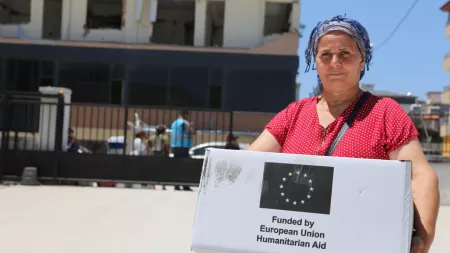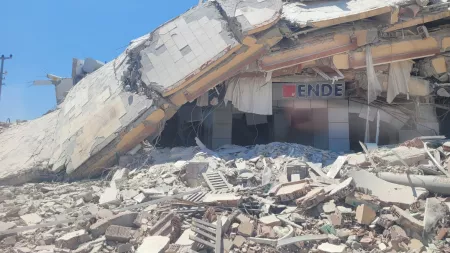Destruction
On February 6, the population of southeastern Türkiye and neighboring Syria were jolted from their sleep by a devastating earthquake. Thousands of people died and tens of thousands were injured. In many places, infrastructure was severely damaged. Six months later, the humanitarian needs are still enormous. The situation for people in the earthquake-affected areas of Türkiye and northwest Syria remains catastrophic. Millions of people have lost their homes, belongings, and livelihoods. CARE continues to provide live-saving emergency aid.
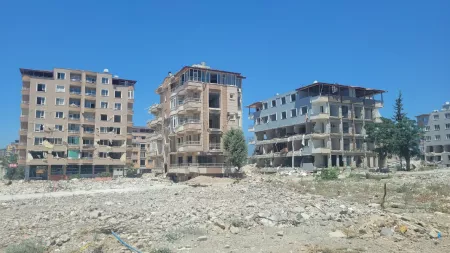
Psychological Impact
Many have lost family members, friends, and neighbors and have faced the trauma of seeing their homes collapsing all around them. Elcin, 38, lost her mother and her children Elena, 8, and Mertcan, 14, in the earthquake. She herself was trapped under the debris of her house for 81 hours. “I felt when my daughter died. We were trapped for 12 hours and then she was gone,” remembers Elcin. Coping mentally with the experience of the earthquake and the loss will be a challenge in the coming months and years.
“Every time I think about what happened during the earthquake, I start crying. It’s too hard to remember,” says Hüsameddin, father of four. When the earthquake hit, he couldn’t find his youngest son Yusuf, 7. “The door was jammed and at first, we could not get out. When we finally reached the stairs, the aftershock hit us, and we could not leave because it was shaking so much. I used my body to cover my family from the falling debris,” he says.
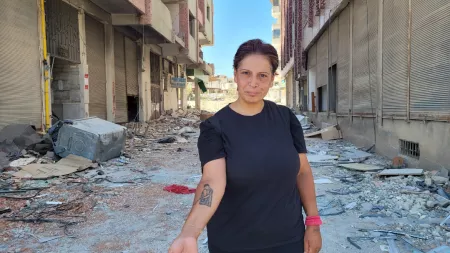
Shelter
Many cities are completely destroyed. Nothing is left but empty building shells and debris. Schools, supermarkets, and hospitals are also not operational. The infrastructure, such as streets and water pipes, is heavily damaged. The inhabitants are living in tents and containers in camps, on the side of the road, or in gardens.
“Living in a container is hard. It is not a home. It is also dangerous for me as a woman to go outside to shower,” says Elcin. Together with her father she lives in one of the containers and depends on humanitarian aid, as she has no financial support because also her work has stopped due to the earthquake. “Everything has stopped. Going back to normal will take a long time,” says Elcin.
Hüsameddin’s family lives together in a tent. “After the earthquake, it became so difficult. We have to start from zero again. Our children do not go to school, and it is hard to live in a tent. There are many insects and during the day it is too hot to stay inside,” says Hüsameddin.
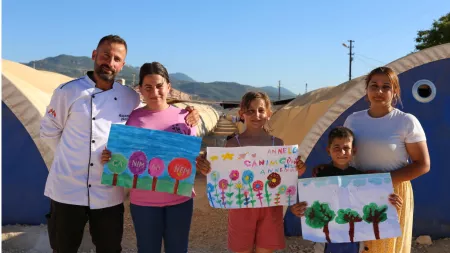
Vulnerable groups in need of assistance
It is especially difficult for people who need special assistance. Aisha’s husband, Elisha, can only walk with physical support from his family and cannot stand up alone. When the earthquake hit, Elisha told Aisha to take their 12-year-old daughter to get out. “What about you, I asked him. I refused to leave him behind. So, my daughter and I struggled to pull him outside. We were lucky to live on the ground floor,” remembers Aisha. Once they were outside, she went back inside to find a chair for her husband to sit on.
Because of the aftershocks, they stayed in a shelter, which was very cold. “When my daughter’s lips turned blue, I knew we had to find a different place to stay.” Aisha attends a session at CARE’s Information Protection Space, a project funded by the European Union, where she learns about the triangle of life. “We learnt a lot. Now, every time we feel an earthquake, my daughter grabs a book and holds it above her head. Then she crouches down next to the fridge,” says Aisha.
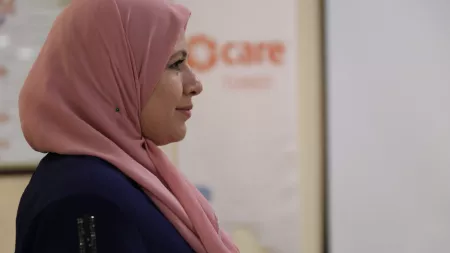
Affected aid workers
CARE staff are also affected by the earthquake. CARE team leader Vural, 33, was in Gaziantep with his mother when the earthquake hit. “I woke up suddenly when the shaking started, and I tried to keep my mother calm as we evacuated. At that time, I thought that we are dying and that everything is going to be destroyed,” says Vural.
As a humanitarian he felt responsible to help his neighbors and everyone affected. For ten days he slept in his car, already organizing aid and the distribution of much-needed items to people looking for help. “It was tough, but I felt good as we were doing important work.”
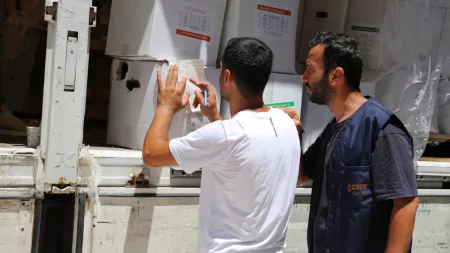
CARE and partners' response
Many people have lost everything they own. Living in a tent, 53-year-old Layla is in need of assistance. “I came to CARE’s distribution today because in our tent we have nothing. We need food, something to wash ourselves, and water. This is so critical for us,” says Layla. Nothing in her hometown was left standing. “Where should we find water? There is nothing left. The city has completely collapsed,” she says. She is one of thousands to whom CARE distributes food items, hygiene kits, kitchen appliances, and drinking water.
In a CARE hygiene kit, funded by the European Union, Layla for example receives towels, shampoo, toilet paper, hygiene pads, toothbrushes and toothpaste, detergent, and sponges. “I want to thank CARE for this. It is so hard for us to live like this,” says Layla.
